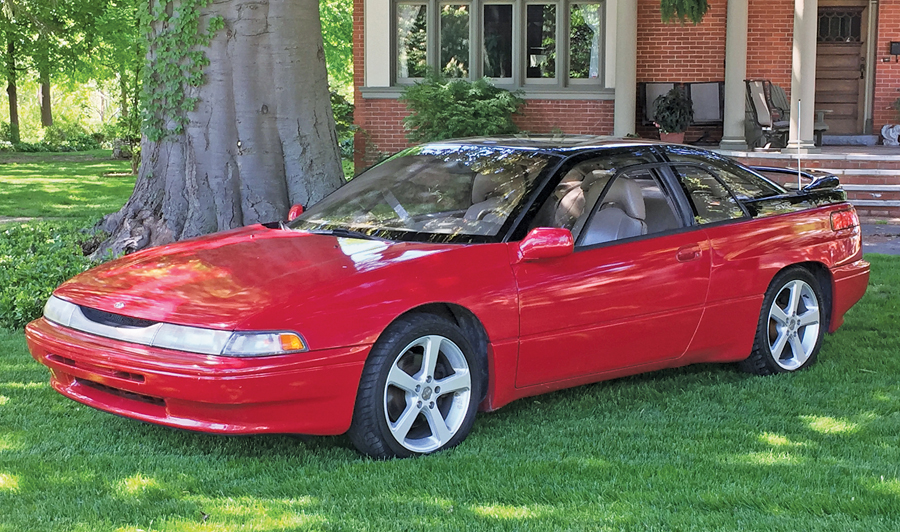
Subaru changed their thinking in the early 1990s — away from funky econobox subcompacts and towards performance and comfort. In so doing, the company ushered itself into a period of commercial and enthusiast success that continues to this day.
Now that 25 years have gone by, Subarus of the early 1990s are moving into collectible territory, starting with the upscale SVX coupe offered from 1992 to ’97.
The SVX stands apart from the main line of Subaru production and development. It has had no successor, and it really didn’t have a predecessor, either. The SVX replaced the XT6, which was a sporty 6-cylinder coupe, but it was underpowered and much smaller than the SVX.
The SVX has a unique look courtesy of Italdesign Giugiaro, and it looks very similar to other cars penned in Italy during that period.
The Pininfarina-designed Alfa Romeo 916 Spider and GTV coupes made from 1993 to ’96 have distinct similarities to the SVX, but no other Subaru before or since looks anything like it.
The thing that everyone notices first about the SVX is the side windows. Subaru used a “window within a window” design that is more often associated with gullwing exotics that can’t roll down a full-size side window. The design allows for more glass area along the side of the car. This gives the SVX an open feeling with almost vestigial A-, B- and C-pillars. The smooth curve of the glass also greatly reduces wind noise and buffeting when the windows are open.
A grand tourer — not a sport compact
The SVX comes with a 3.3-liter DOHC 24-valve 6-cylinder boxer engine, which was the biggest engine Subaru had ever made. The EG33 (as it’s known to Subaru cognoscenti) is related to the EJ line of engines that have powered the Legacy and Impreza from the beginning, but it’s a branch off the main development tree. This is important because it means the SVX engine is an orphan when it comes to replacement parts.
The SVX was rated at 230 horsepower and 224 ft-lb of torque, and it was never offered with any kind of forced induction, so that’s the power you get. All the tweaking and fiddling in the world won’t yield more than a nominal increase.
All SVX models used Subaru’s venerable 4EAT 4-speed automatic transmission, and the early ACT-4 all-wheel-drive system. ACT-4 uses a multi-plate clutch in the center differential and under normal conditions delivers 90% of torque to the front wheels. However, if the front wheels slip, the clutches lock up and deliver 50/50 torque to both axles.
As delivered, the SVX would do 0–60 mph in 7.3 seconds (stated in the sales brochure), and the car had a nominal top speed of 143 to 154 mph, depending on the model year. That was respectable enough in its day, but it was never the stuff of legend.
For the 1994 and 1995 model years, Subaru blinked and lost confidence in its commitment to AWD. They tried offering a de-contented front-wheel-drive version of the SVX to boost sales. However, the FWD car wasn’t that much cheaper than the AWD version, and Subaru dropped the FWD option for the final two years of production.
Contemporary reviews all stressed that the SVX was not a hot rod, but rather a comfortable grand-touring coupe. The SVX received high praise for handling and braking, and the consensus was that this was a high-speed luxury highway cruiser for grown-ups.
A nice ride inside
Inside the SVX, the appeal started with well-designed and comfortable seats.
All SVX models came with leather upholstery, and the suede-covered dash design was unconventional. The climate control features a large round rocker button with a digital display that allowed the driver to easily set the temperature. The stereo was hidden behind a little door on the center stack to preserve smooth dash lines, but Subaru strangely chose cheap woodgrain plastic for the trim. Womp, womp.
As a 2-door coupe, the SVX offers ease of access — to the front seats, anyway. The steering wheel tilts and telescopes, but it has three separate levers that you have to use to set the wheel position.
As a car of the ’90s, the SVX includes those incredibly annoying automatic shoulder belts and a driver’s side airbag. The rear seat can accommodate passengers, but that’s not what the SVX was ever about. The rear seatbacks fold down to create extra cargo space with a pass-through to the trunk.
Spend the money on a top car
The SVX was an expensive purchase in its day. The top trim cost $28,000 new in 1992, and that had risen to $36,740 by 1997.
However, values have been dragging across the basement floor since the cars were 10 years old. The oldest SVX sale records in the SCM Platinum Auction Database are about $3,000 in 2002 (SCM# 36363), and they’ve generally gone down since.
1992–94 SVX models were plagued with transmission problems. This was remedied in 1995 with the addition of a transmission cooler. Any SVX under consideration should be examined for transmission issues, and be sure to ask if it has been replaced.
Similarly, Subaru head-gasket issues were legendary in the 1990s. A head-gasket job on this vehicle won’t be cheap, so ask if it’s been done and definitely do invest in a Subaru-literate pre-purchase inspection.
Today, expected price ranges for a good-quality SVX are $2,000 to $5,000. However, the standard wisdom applies even more strongly to the SVX: Spend the money to buy the very best example you can find. There are few classics more affordable than the SVX, but there is no car in the world more expensive than the wrong SVX. ♦